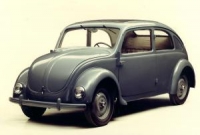Kleinauto Type 32
Dr. Ferdinand Porsche (1875-1951) developed this inexpensive rear-engine small car called the Type 32, or Kleinauto, for the NSU Company in Germany in 1932. It was based on an original small car prototype Porsche had developed, but never produced in 1931 for the Zündapp Works, a motorcycle firm. Porsche had just in 1931 opened his own automotive design firm with his son, Ferdinand "Ferry" Porsche II (b. 1909) , but already had a long and distinguished career of innovative design. Born in Austria, he was hired in 1898 as a designer by Ludwig Lohner, owner of a carriage factory in Vienna, who wanted to produce an electric car and was interested in Porsche's idea of placing the electric motors directly inside the wheel hub, thus eliminating chain and belt drives. The resulting car was the Porsche-Lohner Chaise, which won a grand prize at the Universal Exposition in Paris in 1900, and made Porsche famous. In 1903, Porsche combined a gasoline engine with an electric motor in what he called a "Mixt" car for Lohner. The engine powered a generator which fed electricity to the motors in the wheels. Nicknamed "Aunt Eulalia", the car was a hit with celebrities like Austrian Archduke Franz Ferdinand. In 1906, Porsche became an engineer for Austro-Daimler as a technical director and board member, and joined Daimler in Germany in 1923 where he remained until he was dismissed, when Daimler merged with Benz Cie in 1926. In 1929 he took a key position with Steyr Works in Vienna, but the company soon collapsed financially. Three of his NSU small car prototypes were built in 1933, and they were refined, through a commission by Adolph Hitler, into three VW 3 prototypes in 1936, which were successfully tested by the Nazi SS. Hitler's specifications included a cost of DM990 (US $396), a speed of 100 kph (60 mph), and 40 mpg fuel consumption. In 1938, Adolph Hitler laid the foundation stone for the Volkswagenwerk factory in "KdF Stadt" (after the war renamed Wolfsburg), Germany, and mass production of the Volkswagon Type 38 KdF Wagen (Kraft durch Freude, or Strength through Joy), began. It was designed by Porsche and Erwin Komenda (1904-1966), based on the 1932 prototype Kleinauto. Factory construction was halted in 1939 as war began. Only 210 KdF Wagens were built, and only privileged Nazi officials got them. After the war, Volkswagenwerks in Germany, largely destroyed in 1944 by bombing, was offered for sale to, among others, the Ford Motor Company. The offer was declined by Henry Ford II, as "not worth a damn." In 1946, British Major Ivan Hirst initiated small scale production by German workers of about 1000 cars per month for the British Army. With the Cold War on and the Iron Curtain up, ownership was returned to Germany, and Heinz Nordhoff (b. 1899), pre-war executive for Opel in Germany since 1929, when it was acquired by General Motors, took over the plant in Wolfsburg. Volkswagen soon became West Germany's major postwar industry with 45 percent of the country's output. The Volkswagen was introduced to the US in 1949 by Ben Pon of the Netherlands, the only international distributor of Volkswagenwerks. Volkswagen of America was established in 1955. 330 were sold in the US that year, at a price of $1800, and it soon became known as the Beetle. By 1968, it had captured over 50% of the US import market. In 1974, due to failure to meet US emissions standards, the Beetle was replaced by the Rabbit; however the Beetle continued to be manufactured in Latin America, and sold in the US until 1979's Super Beetle convertible. Over 21 million have been sold to date, far exceeding the total sales of the Ford Model T. At the 1994 NY Auto Show, the VW Concept One "retro-Beetle," designed by Jay Mays and Freeman Thomas of the VW /Audi Simi Valley, CA studio under Charles Ellwood, debuted. The new Beetle was introduced in 1998 at a price of $18,000, ten times its original US price in 1955.
